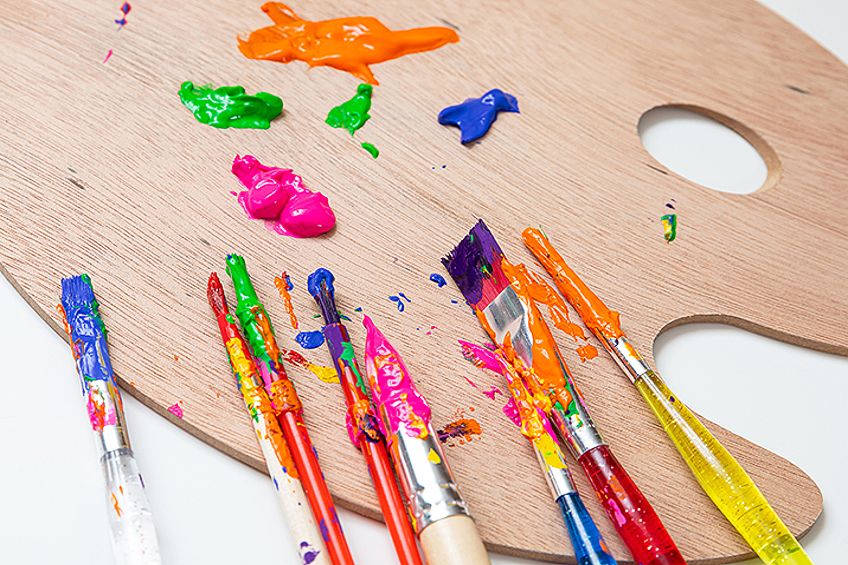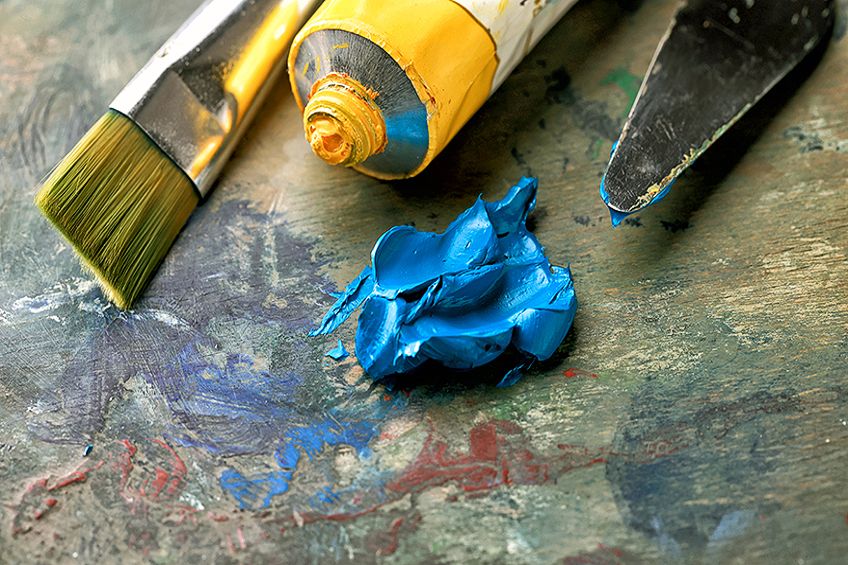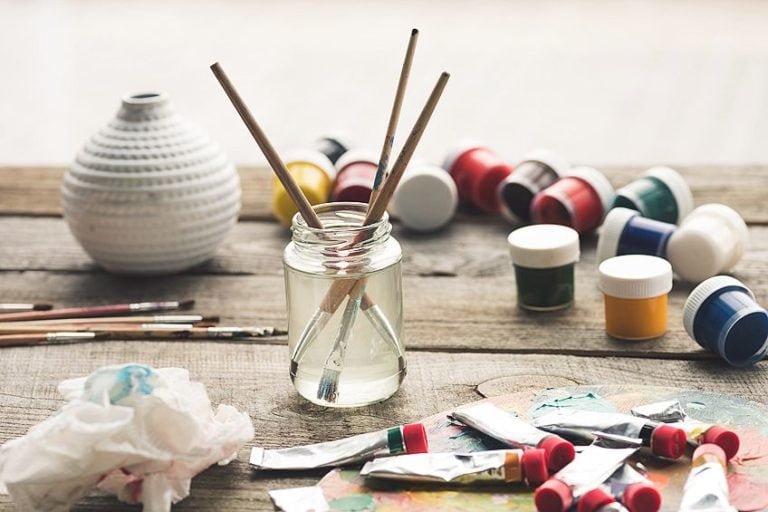Best Gouache Paint – Looking at the Leading Gouache Brands
This post may contain affiliate links. We may earn a commission from purchases made through them, at no additional cost to you.
Everybody knows about watercolor paints, but what is gouache paint? These two artistic mediums might look alike, as both of them have a water-soluble binder. However, when you have a closer look, the consistency is quite different. The gouache paint is thicker and can be seen as a type of watercolor and acrylic blend, which is great for detailed painting and design effects. Gouache paint is highly versatile and provides intense color to your artwork. Read further to find out more about this amazing art medium.
What Is Gouache Paint?
We have already stated that gouache and watercolor paints are very much alike, and that gouache paint is just thicker. The gouache paint, when applied to paper or canvas, dries to an opaque or matte finish. This opaque look is created by the white pigment or chalk that is mixed with color pigments. The color pigments in watercolors and gouache are also alike, although the pigment particles in the gouache paint are a bit bigger. This is the reason as to why gouache paint tends to be thicker in texture.
The best gouache paint dries quite fast, which is great for adding finer details to your work. You will also find that the colors are more vibrant or solid. You will discover that the gouache paint does dry differently, however. Lighter paint colors tend to dry darker, while the darker colors dry lighter; once you get used to this, it should not affect you in any way.

Switching from watercolor to gouache paint and vice versa should not be difficult due to the similarities of both paint mediums. You can paint on the same surfaces, such as canvas or paper, and you can even use similar brushes. As the gouache paint is water-based, it is easy to use and clean up. Gouache paint is versatile in that you can mix it with watercolors or water to create unique effects.
Gouache paint does differ from watercolor paint in some ways, however, which means that gouache paint cannot be used in the exact same way as watercolors.For example, adding too much water can make the gouache paint too runny, or adding too little can cause your paintwork to crack over time. The texture of the gouache paint needs to be balanced, having a smooth, creamy consistency that is easily applied to your surface. Gouache paint also has amazing blending properties, as it remains on the surface of your paper or canvas instead of being absorbed. You can also re-wet the paint to make adjustments if needed.
Next, let us see what tools you need to start practicing your gouache painting.
Materials Needed for Gouache Painting
To get started with your gouache painting, you will need to get a few materials together. You might even have to do a little reading up on the subject if you are new to this medium. You do not have to worry, though, as we have also provided a few product recommendations that should help you choose the best materials, tools, and paint.

Setting Up Your Gouache Palette
When starting a painting project, there are many things to take into consideration. It may be a good idea to do a little research to see what other artists are doing and what gouache brands they are using. Since there are so many products available, you can at least get an idea of what is best to use. You can then choose the best gouache paint set for your project. You can easily purchase a basic gouache paint set with a few colors and then build up to a wider gouache palette as you go.
When blending your gouache paint, it is best to use a paint palette or tray. A plastic palette may not be the best option in this case, as gouache paint and some gouache brands tend to stain the plastic. A better gouache palette option would be to use a glazed or even a clay surface, as these will not hold on to the pigment color like the plastic.
When you store the gouache paint for some time, it might become crumbly and dry. This is not a problem and you can simply add a little water to get the correct texture and color back. Many other types of paint have a plastering agent which helps keep the paint moist, so they will not dry out like the gouache paint.
Best Gouache Paint Brushes
In many cases, natural brushes are considered the best option for painting. However, when working with gouache paint, the opposite might be true. This is because natural brushes tend to retain more water and this creates a paint that is thinner and will therefore be more transparent once applied. Synthetic brushes provide more control and will also not create any streaks.
When it comes to the shape, it does not matter as it does for oil painting or acrylic painting. The main objective is to keep the brush wet while painting so that you can work properly with the gouache paint. The best gouache paintbrush would be that which you use for watercolors. Since both watercolor and gouache are water-based, the brushes will work best with this medium as well.

Best Paintbrush for Gouache Painting: TRANSON Artist Paintbrush Set
The Transon paintbrush set gives you 12 differently shaped paintbrushes, all of which can be used with other mediums like acrylic and oil paints. There are different sizes and shapes, including an angled brush, flat brush, filbert, and a round brush to help you create multiple effects and art designs. The brushes themselves are excellent-quality nylon and each brush is hand-made. These are versatile brushes that can be used on canvas, for model painting, rock painting, and more.
- A wide range of assorted premium, hand-made nylon paint brushes
- Versatile brushes that are suitable for use with different media
- Brushes have an ergonomic handle grip and durable ferrules
PROS
- Affordable price
- Easy to keep clean
- Versatile and can be used with other mediums
- Different shapes and sizes of brushes
- Good-quality brushes
CONS
- Brushes can be too hard
Best Gouache Paint
Gouache paint is, as we now know, water-based and will respond to liquids. So, you will need to protect your artwork for it to last a long time. Many apply spray sealants or use fixatives to protect their painting. Framing the artwork and keeping it behind glass is also a good idea. Finding the best gouache brands will also go a long way in producing your best work. Below are a few recommended gouache brands that you might find useful.

Best Overall Gouache Paint Set: ARTEZA Gouache Paint Set
The Arteza Gouache Paint Set is a comprehensive 60-color paint set that will provide a thick matte finish. You only need to use a little each time, as the paint goes a long way. The paint will dry fast, but it can always be reactivated once dry by simply adding a little water. There are a variety of colors including some metallics, pastels, earth tones, and pearly options. The vibrant color paints are non-toxic and can be used safely by everybody. Along with the set is a color chart for reference purposes. The painting set also comes with a warranty and support, so satisfaction is guaranteed.
- Paints are richly pigmented, with a dense, opaque, and matte finish
- The thick nature of these paints allows for maximum coverage
- The paints are quick-drying but can be reactivated with water
PROS
- Wide choice of vibrant colors
- Includes metallic, pastel, and pearlescent options
- Easy to use and non-toxic
- You only need a little paint for great coverage
CONS
- Not a lot of skin tone shades
- Metallic colors do not cover darker colors well
- Colors may not appear opaque enough, requiring multiple layers
- Cannot get individual colors
Best Introductory Gouache Paint Set: WINSOR & NEWTON Designers’ Gouache Paint Set
The Winsor and Newton Gouache Paint Set offers six primary paint colors that you can also purchase individually. This is one of the best gouache brands, as they have been going since the mid-1930s. The painting set is ideal for beginners, as it has the four primary colors as well as white and black for blending purposes. The Winsor and Newton gouache paint set is an ideal base for producing a great gouache palette that you can build on. The formula has been improved recently and now provides smoother application and more vibrant colors.
- Opaque colors renowned for their color brilliance and matte finish
- Paints are smoother, flatter, opaquer, and more brilliant than ever
- Paints are widely used by professionals as an opaque water color
PROS
- Great for beginners
- Good blue for money
- Respectable and top-quality brand
- Can purchase paints as individual colors
CONS
- Paints can stain plastic palettes
- Reports of difficulty cleaning brushes
- Paints might smell funny
Best Professional Gouache Paints: M. Graham Gouache Paint Set
The gouache paint by M. Graham is more for the professional artist and comes in a set of five colors: blue, red, yellow, white, and black. The bold colors are achieved by using pure blackberry honey, which creates more vibrant and deep colors. The paints are safe to use as there are no chalks or other adulterants. The deep, matte finish of the paint can be applied alone or used as a mixed media option with watercolors. You can also purchase individual colors, so you can add them to your set once a color tube is finished.
- Artist-quality gouache paints made with pure blackberry honey
- Free from chalk and opacifying adulterants, making them safe to use
- Reflective matte finish can be used alone or with watercolors
PROS
- Ideal artist-grade gouache paint brand
- Excellent quality
- Safe to use
- Can purchase as a set or as individual tubes
CONS
- Can be expensive
- No green color available; you need to create your own
So, now that we have discussed the best gouache paint and materials, let us have a look at the various techniques and uses.
Gouache Paint Uses and Techniques
Gouache paint is used mostly for pieces like poster boards, illustrations, and designing comics because it can be used for finer details. Some other uses also include using the gouache paint in layouts, design concepts, as well as in backgrounds on sets for film making. The versatile paint provides the qualities of both watercolor painting and acrylic. The paint is also perfect for layering and provides more contrast than other thin mediums. You should also be able to find some affordable gouache brands, making it a painting medium that everybody can afford.

Gouache Staining
This technique is perfect for creating landscapes or skies, as it forms the first paint layer that you can build upon. Simply wet the end of your brush, dip it into some paint, and apply a thin layer over your surface. This is the first layer and forms the background for your art piece. From this, you can then build up and layer your colors.
The water allows you to work with the paint more easily and when the paint dries, you can easily re-wet it to work on it again or layer more colors. When applying layers, ensure each layer is dry before adding the next one, otherwise the layer underneath could be affected, and you could have unwanted mixing of colors.
Gouache Glazing
This is almost the same as staining, except that it is used in other parts of the painting. The gouache paint dries fast and can act like watercolors in terms of its transparency. Take a wet brush and then a little paint and apply this to an already painted section of your art piece. This new wet-color application will provide a transparent effect, enhancing or changing the color underneath it. Adding more layers will ultimately hide or change the color that was underneath.
Glazing is great for creating shadows and darkening parts of the painting. Using different amounts of water to paint, you can create all kinds of effects.
Gouache Blooming
This technique can be used as a base effect to build upon and is perfect for more abstract art. You can create irregular color shapes that bleed into each other. Thoroughly wet the brush and add a small amount of paint, after which you can lightly apply the brush to your paper surface. You should see the paint spreading and “blooming”.

Gouache Layering
Create overlapping colors and hide underlying layers to create texture. This technique is also known as dry brushing, as you will be brushing on paint in short, quick strokes with no water. Apply your brush strokes lightly, as this will give you an effect that is rough in appearance. This technique, also called opaque layering, is perfect for creating things like clouds or greenery in paintings.
Blending Gouache
Since gouache is water-based, it can be wet again once it has dried and worked on to create the effect you are looking for. Even if the paint has been left to dry for days, you can still re-wet and work with it again. Wet the brush and apply it to the painted area to soften the paint. Surrounding colors can then be drawn in to soften the color, or you can apply fresh paint to the area.
You can also try the blurred stroke effect, where you paint on your first layer of color and allow this to dry, after which you will take a contrasting color or darker color over parts of your first layer. This is suitable for applying highlights and darker layers, as well as blending and changing colors.

Frequently Asked Questions
What Is the Difference Between Gouache, Watercolor, and Acrylic Paint?
Gouache paint is thick like acrylic and also has watercolor properties, and is therefore a blend of the two mediums. Gouache paint tends to dry more quickly than acrylic, but is responsive to water. This means you can reactivate the paint once it has dried in order to work with it again. Gouache paint also has bigger pigment particles that, once applied, produce a more matte or opaque finish.
What Is Gouache Paint?
This is a water-based medium and is similar to watercolors. The difference is in the make-up and consistency; gouache paint contains a chalk additive that makes it thicker and provides more of a matte finish. Gouache paint is also easier to reactivate once dry simply by adding a little water to the paint.
Are There Any Celebrated Gouache Artists?
This particular art medium was discovered in France as early as the 18th century. Since then, there have been a few well-known artists who have enjoyed using this type of paint, including Valentin Serov, Marc Chagall, Salvador Dali, and Boris Kustodiev.
Now that you know a little bit more about gouache painting, we hope you are convinced of the amazing potential this medium has. Go and experiment, paint, and create a masterpiece of your own using your gouache palette of colors.
Larissa Meyer is a 32-year-old mother from Michigan and creative spirit since childhood. Her passion for painting and drawing has led her to an education as an illustrator and a career as a freelance graphic designer. She has a Bachelor of Fine Arts in Illustration and a degree in Graphic Design. Larissa is a talented artist who is able to master a wide range of styles and techniques to bring her artistic vision to life. Her greatest passion is currently fluid painting and epoxy resin art. As a mom of two kids, Larissa also understands the importance of fostering creativity in early childhood. She uses her experience and knowledge to help other parents inspire their children and develop their artistic skills as well.
Learn all about Larissa Meyer and Fluid Painting.












